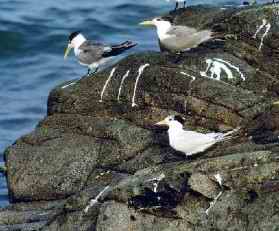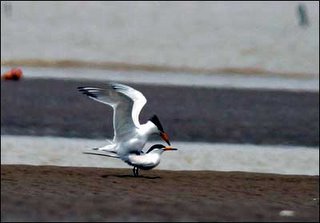
黑嘴端凤头燕鸥是鸥科鸟类最稀有的一种,所以有[神话之鸟]称谓。自1863年被正式命名之后,只有五笔。然而最近两次1980年在泰国与1991年中国黄河三角洲虽都传闻有所发现,但未被证实。
“他们混居在凤头燕鸥群中确实不易被发现,但我们所拍摄到的影片实在太清楚了,”梁皆得说,一般凤头燕鸥身长是45公分左右,最明显的是尾端分叉如燕,头部竖起如庞克头的黑色冠羽,嘴部呈黄色。而黑嘴端凤头燕鸥最明显的不同是,它在黄色嘴的尖端还有一抹黑。专家估计全世界可能不到100只,在世界鸟类红皮书中被列为[濒临绝种]等级。

由於黑嘴端凤头燕鸥的资料实在太少了,没有人能笃定描述它们的分布地、外观、与习性。“我们可以依这次拍摄到的结果推测,它可能与凤头燕鸥类似,喜欢栖息于港湾、河口、岛屿,单独或成对飞行,以鱼虾为食,” 梁皆得说。
拍摄小组成员生态摄影家林显堂说,这次发现的四对成鸟各孵化出一只雏鸟。可惜的是,四对成鸟的栖息处与其它凤头燕鸥混杂,在那样的环境中,很难分辨出黑嘴端凤头燕鸥的雏鸟外观有何差别。后来由于风浪大,登陆困难,拍摄小组计划被耽搁,再登上燕鸥保护区时,黑嘴端凤头燕鸥已经迁移,错失进一步观察雏鸟的机会。民国50到70年代,马祖地区每年有30几种鸟类在附近无人岛上繁衍,最多时曾高达数万只。之后因居民滥拾鸟蛋,附近大陆船只炸鱼情形严重,数量急剧减少,连江县政府因而在民国88年将北竿乡的白庙、中岛、铁尖岛、三连屿、进屿、南竿乡的浏泉礁,吕光乡的蛇山,东引的双子礁等8个无人岛列为燕鸥保护区,并开始记录生涯。
目前马祖地区主要的夏候鸟有白眉燕鸥、凤头燕鸥、红燕鸥、苍燕鸥、黑尾鸥、岩鹭、白腰雨燕等7种。其中黑尾鸥为全国唯一繁殖地;红燕鸥已被国际列为受严重威胁的保育鸟类;在马祖繁殖的凤头燕鸥则是世界分布的最北限。
这些燕鸥五月初自南方陆续抵达,开始求偶繁殖,九月初离开。几乎一整个夏季都呆在马祖地区。
连江县政府有意将保护区规划成生态旅游的景点,然而候鸟繁殖习性容易因人类干扰而改变,如何规划,达到保育与游憩的两全,是目前连江县面临的挑战。
Star Terns-Mystery Seabirds Come Back from Oblivion
The Chinese crested terns is the rarest number of the gull family(Laridae). Since it was first given a scientific name (Sterna bernsteini) in 1863, there had been only 5 confirmed sightings of this bird, and the last two - in Thailand in 1980 and in China's Yellow River delta in 1991-were not confirmed.
"They live mixed in with greater crested terns, and this makes them really difficult to pick out. But in our film they do show up very clearly," says Lianf Chieh-te, who was commissioned to film greater crested terns by the Lienchiang County Government . The greater crested tern is around 45 centimeters long. Its most distinctive featurs are that it has a forked tail like a swallow, a crest of black feathers on its head rather like a Mohican haircut, and a yellow beak. the most visible difference of the Chinese crested tern from the greater crested tern is that its yellow beak has a black tip. Experts estimate that there may be less than 100 of the birds alive in the world today, and the species is listed as critically endangered in the world bird red data book.
Because there is so little information available about the Chinese crested tern, no-one can describe its distribution, appearanceor behaviourwith any certainty. "From what we filmed, we can surmise that like the greater crested tern, Chinese crested terns' preferrd habitats are harbors,estuaries and islands, and that they fly singly or in pairs and feed on fish and crustaceans," says Liang Chieh-te.
Nature photographer Lin Hsien-tang, who was a member of the camera team, says that the four pair of adult birds discovered this time each hatched out a single chick. Unfortunately for the observers, the four breeding pairs' nesting sites were amongst those of the greater crested terns, and under these conditions it was very difficult to distinguish how the appearance of their chicks might differ from that of greater crested tern chicks. Later, because strong winds and heavy seas made landing impossible, the camera team's plans were delayed. the next time they were able to land on the islet where the birds were filmed, the Chinese crested ternhad already moved on, so the team missed the opportunity to observe them more closely.
From the 1960s to the 1980s, over 30 bird species regularly bred on uninhabited islands of the Matsu Archipelago, and at their peak their breeding populations numbered several tens of thousands. But later, because of excessive egg collecting by local inhabitants, and the widespread use of explosives by mainland Chinese fishing boats nearby, their numbers fell dramatically. In response, in 1999 the Lien chang County Government designated eight uninhabited islands-Paimiao, Chung Island, Sanlien Islet and Chin Islet in Peikan Rural Township, Liuchuan Reef in Nankan Rural Township, Sheshan in Chukuang Rural Township and Shuangtsu Reef in Tungyin Rural Township-as gull refuges, and began recording the birds' natural history.
At present, the main summer-resident birds in the Matsu Archipelago include seven species: the bridled tern, the greater crested tern, the roseate tern, the black-naped tern, the balck-tailed gull, the eastern reef heron and the northern white-rumped swift. Matsu is the only place in the whole of the Taiwan Area where the black-tailed gull breeds, and is at the northernmost limit of the greater crested tern's breeding range. The roseate tern is listed internationally as a critically endangered species.
Terns arrive in Matsu from the south in early May, and start looking for mates. They leave again in early September, having stayed in the Matsu area almost all summer. The Lienchang County Government would like to make the gull refuges into an ecotourism attractions, but the birs' breeding is very easily disrupted by human disturbance. implementing such plans in a way that properly meets the needs of both conservation and tourism will be a challenging task.
摘自光华2001年6月26卷第6期

物种名称:黑嘴端凤头燕鸥
图片作者:Karen Phillipps. 00351 281 325590
物种特征:中等体型(38厘米)的凤头燕鸥。特征为黄色的嘴尖端黑色。冬羽额白,顶冠黑色而具白色顶纹,使枕部成"U"形黑色斑块。与大、小凤头燕鸥的区别在黄色的嘴其端部三分之一为黑色。亚成鸟似小凤头燕鸥的亚成鸟,但褐色较重,翼内侧色浅并具两道深色横纹,背及尾近白而具褐色杂斑。 虹膜-褐色;嘴-黄色,前端黑色;脚-黑色。
叫声:沙哑的高叫。
分布范围:据认为繁殖在中国东部,冬季南移至中国南海、菲律宾并偶至北婆罗洲。
分布状况:全球性依赖保护(Collar et al., 1994)。非常罕见,可能已近绝种。以往认为在山东沿海繁殖。
习性:同其他凤头燕鸥。喜开阔海域及小型岛屿。
转摘自http://www.chinabiodiversity.com/search/detail.shtm?cspcode=020870033

